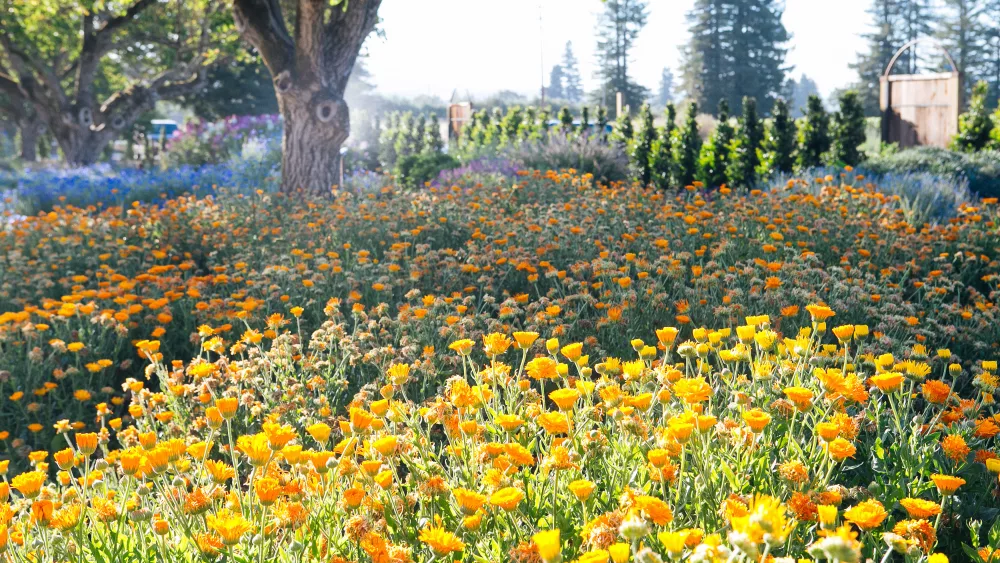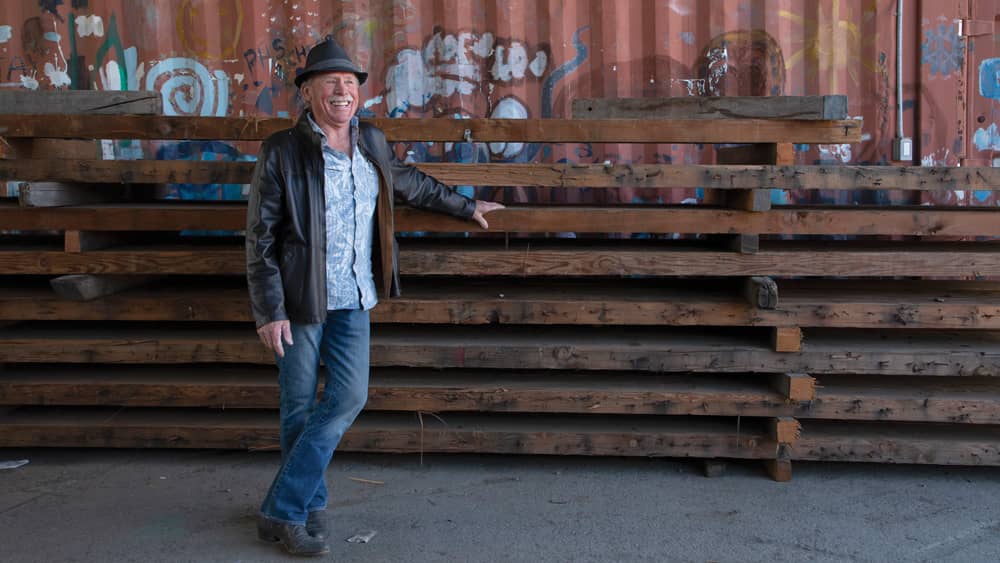
The mural painted by Amandalynn and Lady Mags on the old sheds at the entry to Heritage Salvage is titled, “Harmony in Transformation.” The theme sets the stage for what lies within. Stacks of reclaimed lumber, timber, slabs and architectural elements in the 3-acre yard sit waiting to be reborn. Planks and beams come from an array of sources—Midwest barns, Petaluma chicken coops, Washington State grain elevators and bleachers from a Kansas City school gymnasium. Tags identify the type—cedar, cypress, redwood, fir, pine and hand-hewn. Each piece exhibits the character of wear, the fine grain of old-growth and a rich patina that comes with age. “Our business is all about sustainability and preserving a heritage,” says Michael Bug Deakin, founder of Heritage Salvage. “Using reclaimed wood keeps trees in the ground and history alive.”
Deakin, one of 10 children, hails from Nelson, British Columbia. His mother hung a poem on the cupboard near the doorjamb where the kids lined up to get measured:
Through fear of taking risks in life
I’ve missed a lot of fun
The only things that I regret
Are those I have not done.
As the family story goes, his mother, Ivy Thatcher, was gifted the poem by her landlady at the end of World War II. Ivy was living at a boarding house in Vancouver. “She told her landlady she was heading to Victoria to find herself a sailor,” says Deakin. “And she did!” The landlady was sorry to see Ivy go since they had so much fun together and asked Ivy what she would like to take with her as a memento. Ivy requested the poem. It was cut out of the back page of Reader’s Digest with the rope filigree around it. “The poem guided my life’s journey,” he says.
Deakin grew up in the ’60s, a time of cultural rebellion. When his father suggested he cut his hair, shave his beard, or else, Deakin opted for the “or else.” He loaded up his ’57 Pontiac and headed for Vancouver. There he got his first taste of construction. He and three buddies built a four-bedroom, cantilevered loft in Mudflats, a community of writers, artists and squatters. “It was my first house and building project using recycled materials,” says Deakin. Larger jobs soon followed, from building movie sets to large outdoor entertainment venues that attracted the likes of Jimmy Buffett and Emmylou Harris. Ultimately Deakin settled in California. In 1998, when he landed a contract to build the replica of a 100-year old Tuscan house, he needed old wood. He placed an ad in the newspaper for tumbledown barns and chicken coops. He received 36 replies. The first one he answered was to clean out a shed at a ranch owned by actor Fred MacMurray. That became the genesis of Heritage Salvage.
Deakin’s office is in a 1974 International Harvester truck overlooking the Petaluma River. “The farmer said if I could get the truck out of the mud grave, I could have it,” he says. Like the salvage yard, the office interior exudes character and history. There are family photos, a collection of vintage fedoras—Deakin’s trademark attire—and a 1974 Black & Decker coffeemaker. In a nod to technology, a laptop inventories photos tracking years of Heritage Salvage projects.
“We were one of the first to link salvage with custom design,” says Deakin. “Now there’s competition. And that’s okay. This means more people are into sustainability, and more people spreading the word.” The business is split about 50-between 50—material sales and custom design-build. Eleven employees work at the company. His general manager, Karen Dondero, as well as assistant general manager and yard manager, Chris Raby, run the place and assess the value of wood purchases. Skill sets include welding, sales and design, forklift driver, sawmill operator, deconstruction specialist, three woodworkers, and a specialist and evaluator of deconstruction projects. “We have a terrific team,” he says. “We have a lot of fun doing what we do.”
Heritage Salvage sources materials from buildings that have outlived their original purpose. With ingenuity, skills and craftsmanship, the structures are salvaged and born again. Following are a few examples of several projects completed by Heritage Salvage over the years.
Saving San Francisco history
In 1925, the Automobile Club of California opened its headquarters on Van Ness Street in San Francisco. With the future of the club uncertain, the architect provided a backup plan in the event the association didn’t pan out. He incorporated unique features in the lobby—a dome, arches, frescos, balconies and parapets, and beams stenciled in shades of red, yellow and green. If need be, the building could be sold off as a luxury hotel. The country moved into the age of the automobile and the association prospered, eventually relocating to larger quarters.
Over the years, the Van Ness building fell into disrepair. The 1960s remodel wrapped the structure in a skin of glass and steel, obscuring the history within. In 2015 a developer, to make way for condos planned to demolish the structure with no intent to salvage the unique lobby and its history. Too expensive to do that, they said. Deakin, not one to shy from controversy, stepped in. He sent a column he was writing for the San Francisco Chronicle about the renovation in the city. It was titled, “ The Good, the Bad and the Ugly.” Deakin suggested the principal only need to scroll to the ugly to find themselves in it. The developer relented and Heritage Salvage ended up with 22 cases of lobby history. “Rather than rotting in a landfill, the materials were repositioned in 120 projects, many of them for car buffs wanting to save a piece of history,” Deakin says.
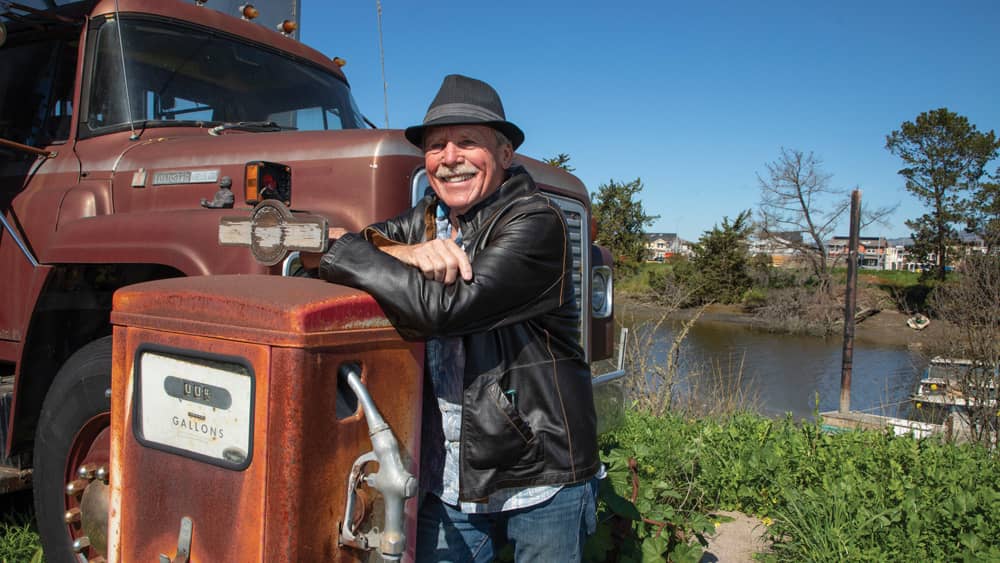
“The building had been constructed below the water line in an 8-foot deep foundation of redwood timbers,” Deakin says. “I watched the tides rise and fall in the elevator shaft as we reclaimed the treasures. We saved fir beams dating back to 1851, original redwood, columns milled from old ship’s masts, wooden doors and a few street lamps.”
Providing old charm to new places
Heritage Salvage materials and custom-design work is featured in more than 165 bars and restaurants throughout the country. Three of those are the HopMonk Taverns and Twin Oaks, owned by Dean Biersch, CEO and founder. “When I moved to Sonoma 20 years ago, I wanted to create a restaurant with a beer garden, good food, live music and atmosphere, like what I’d seen traveling in Europe in my backpacker days,” he says.

Based on the success in Sonoma, Biersch and Bug moved on to the HopMonk Novato location. “Dean wanted to keep the flooring a little lighter,” Deakin says. “So we used milled shiplap from an old grain elevator. The wood’s reversible so we used boards on the newly milled side, while alternating sides and sizes. It worked perfectly.” The outdoor Novato beer garden has repurposed chicken coops, slab tables for gatherings, and the stage for live music is made of planks from Rodney Strong Vineyards.
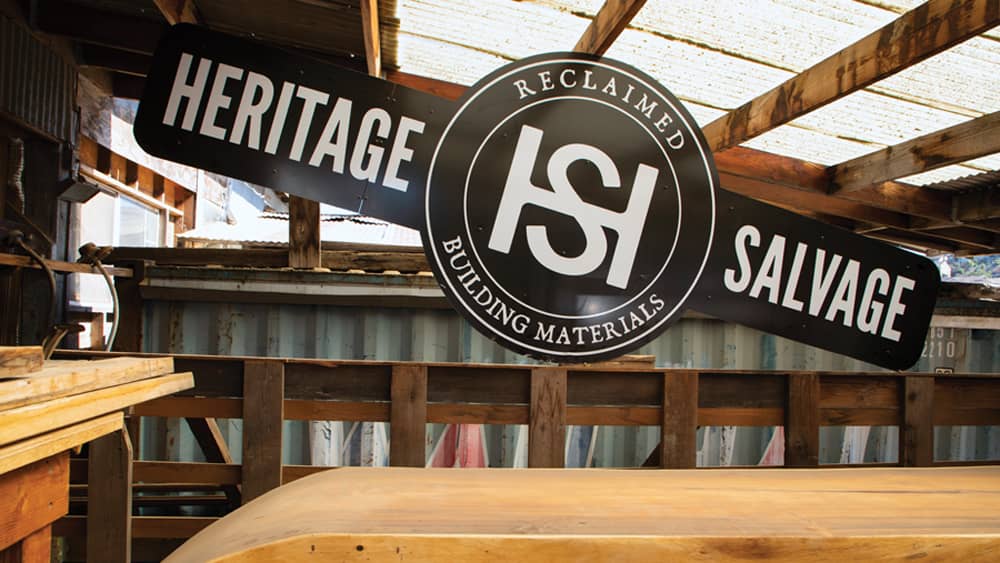
Repurposing a historic New England landmark
Heritage Salvage’s builds extend cross-country—from San Francisco to New York and from Seattle to Atlanta. Their materials come from across the country, including the Rockingham Park Racetrack in Salem, NH, just outside Boston. In 1906, 10,000 people attended the track’s opening. Rave reviews proclaimed the 170-acre site “the finest racetrack in the world.”
Though betting was illegal in New Hampshire, a 21-day thoroughbred meet with betting followed the track’s inauguration. After three days, gambling was officially canceled though money continued to pass under the table. The track sat idle for five years until pari-mutuel wagering, also known as pool betting, was legalized. The champion thoroughbred Sea Biscuit raced there. Undersized and knobby-kneed, the thoroughbred gave hope to millions during the Great Depression. In 2015, to make way for housing development, a wrecking ball fell on the famed racetrack. Wood from the horse paddocks was loaded onto a semi-truck and the stalls were transported cross-country to Heritage Salvage’s yard in Petaluma.
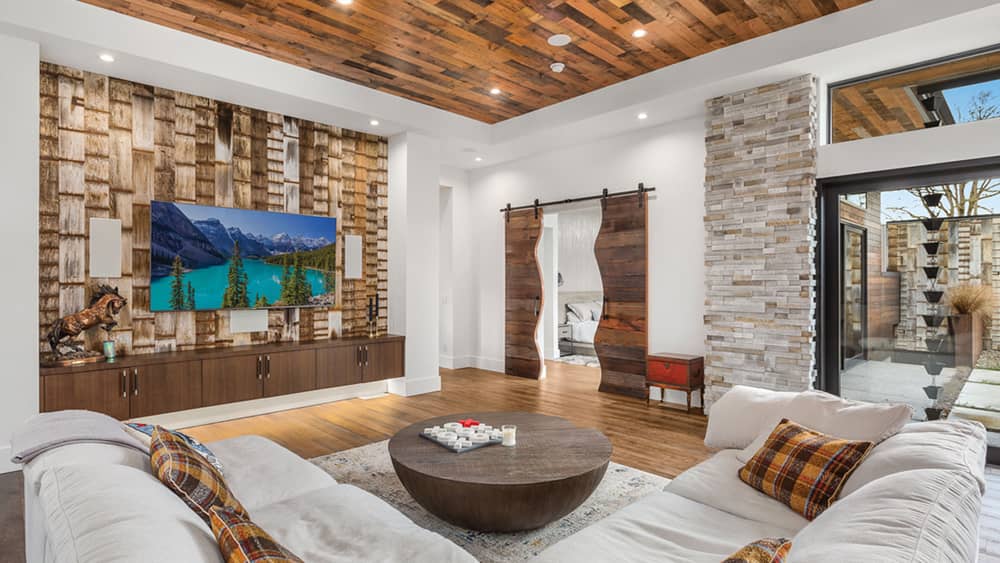
Sourcing wood from Costa Rica
In addition to old barns, chicken coops, grain elevators, warehouses, school bleachers and brick-and-mortar stores of late, Heritage Salvage sources sustainable wood from Costa Rica. Approximately half of the country’s GDP is derived from eco-tourism.
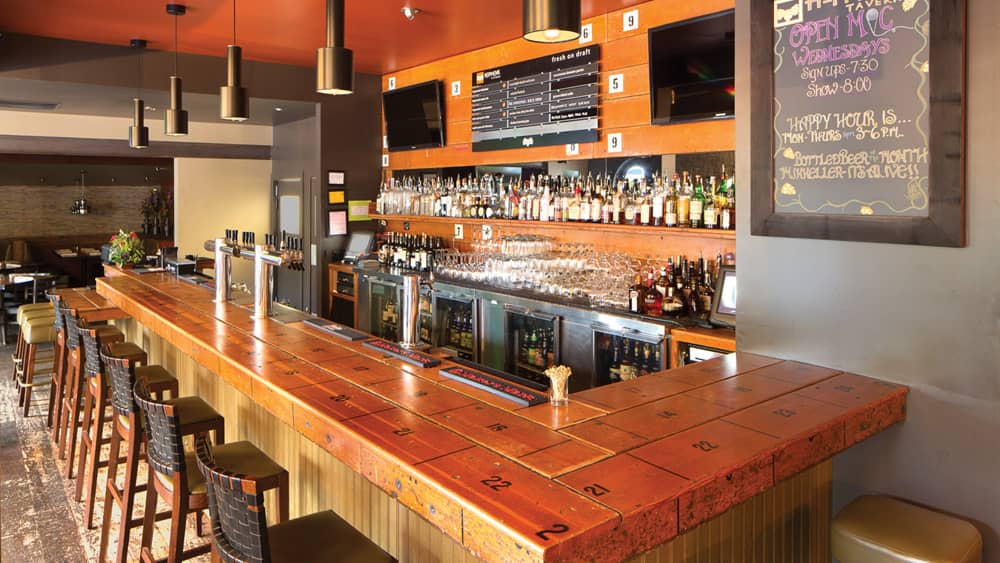
Residential projects
The company’s custom work for new bars and restaurants slowed during the pandemic. “The high-end residential market is still strong, so we’re focusing on doing more of that,” Deakin says. “We team with residential contractors for specialty construction using reclaimed materials for paneling, doors, floors and ceilings and bookcases”
A home in Lake Oswego, Ore., showcases Heritage Salvage materials and workmanship. The media nook and courtyard walls are redwood staves from a 50,000-gallon water tank. “Wood from water tanks has no knots, otherwise the knots would pop out,” Deakin says. The master bedroom there has a sexy curvilinear sliding door of vertical grain old-growth redwood sourced from a home in Mill Valley. The ceilings and soffit are 5-inch milled shiplap from a Washington state grain elevator. The use of wood-constructed grain elevators has been banned by the state due to fire risk. Built-in rural areas up until the 1940s, they’re now a source of wood for reclamation. The walls are built of fir planks flat-stacked in widths of decreasing size. Stacking provides the strength needed to withstand the pressure of the tons of grain within.
Heritage Salvage work includes not just sourcing materials but finding the right home for what’s reclaimed, doing the custom design and the build-out. “If you can draw it on a bar napkin, we can build it,” Deakin says.
A man with ideas
“Businesses, and people too, should be alert to opportunities and reinventing themselves,” Deakin says. Following the disastrous 2017 Tubbs fire, he spoke to firemen who tried to save Coffey Park. “Two fire trucks responded quickly, both arriving at the same time at opposite ends of the block. Fire raced along the tops of wood fences surrounding the homes. Within minutes the houses caught fire too, and everything was gone. There was nothing they could do.” Seeking a solution, Deakin developed and patented a synthetic fireproof wood called Firebreak 101. It comes in a number of finishes, from rustic to smooth. It has the look and feels of real wood. “The material is still in the test stage. And we’re working on being able to do large production.” Deakin won’t divulge the composition, other than to say its 70% reclaimed materials.
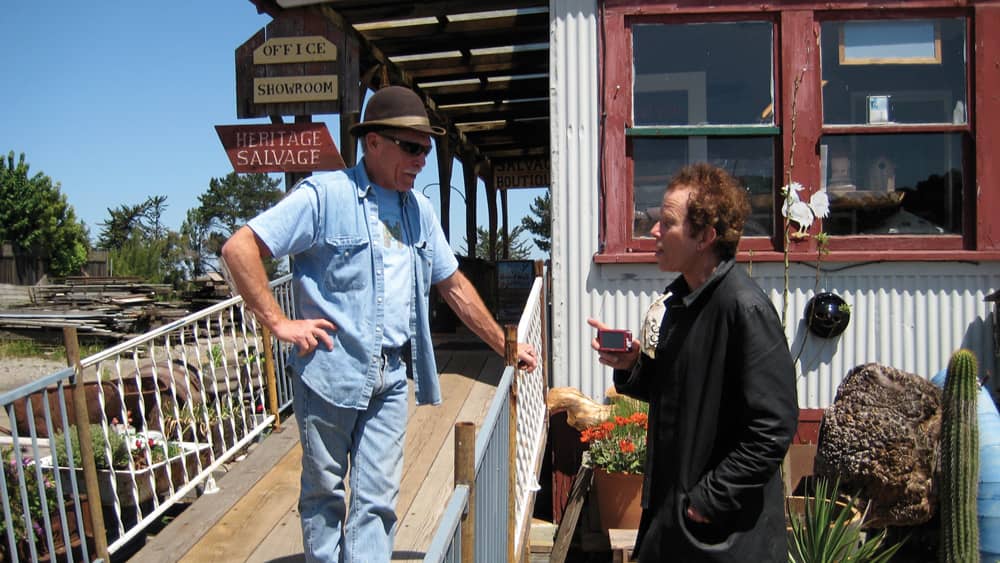
Not All Projects Pan Out
While Heritage Salvage is committed to sourcing materials from old structures, not all projects pan out. For example, once a Heritage Salvage team of four went to the Point Reyes coast to take down an old barn. “After five hours we’d only removed two boards,” says Michael Bug Deakin, founder of Heritage Salvage. “The saltwater spray had welded the nails to the studs and joists. We packed up and went home.”
The Cost
Why does reclaimed wood cost more? “Salvage work is time-consuming. Demolition starts at the top, in the reverse order of the way the structure was built. Often times we have to remove all the nails and fixtures that keep the building together,” says Bug Deakin, founder of Heritage Salvage. “It’s not sexy work,” he adds. “It’s hard to find crews to do that. Yet the end result is material that provides a unique look, is a part of history and comes with a story.” With significant increases in the price of lumber over the past year, the cost of new wood is approaching that of wood that’s been reclaimed.




